#food recipe vintage food
Explore tagged Tumblr posts
Text
Challenges
My spouse has learned that possibly the most dangerous words said in our house are “So I was watching a video online...”
Now, it doesn’t mean I’ve been radicalized by the algorithm. It means something far worse: I saw a recipe online and thought it was interesting.
Interesting does not mean good. It almost certainly does not mean familiar. It means I see potential and I intend to try it.
One of my favorite channels is Dylan Hollis on Tiktok. He does vintage recipes, mostly from the early 20th century, largely very bad recipes. Stuff that you’re asking “Why would anyone even try this?”. Though a fair number are from the Great Depression and WWII: just people trying to make do with what they had.
Now, in large part his popularity is because he’s outlandish and funny in a way that’s neither mean nor reliant on someone being a complete idiot - it’s a comfortable kind of funny. But it’s also an interesting window on an important but often overlooked part of our culture.
At any rate. Sometimes he pans a recipe in which I see potential. I recognize they’re bad, but I am left with the impression they could be made better. One such was the cheese cookies from the 1980s (the trick, essentially, is to about double the amount of cheese). Now, the key, to me, is making it still be recognizably the thing he made - just improved. That is, when I set out to make the cheese cookies the point was to start with the cheese cookie recipe he used: I had several people pop up with various cheese biscuit and scone recipes, and I’m sure those were fine, but the goal wasn’t “Make an enjoyable baked good which contains cheese”; rather it was “Modify the cheese cookie recipe until I have something which is enjoyable”.
Now, most recently, he made a WWI Trench Cake which, predictably, was bad. But I couldn’t see anything about it which was actually awful - we’re not talking the asparagus cake (I think it’s German). But the Trench Cake, well, it has all the right elements to be a decent enough tea cake, it’s just... restrained. Which makes sense because it was explicitly made for WWI. That means less spices, less sugar, less oil, butter, and eggs, substitution for cheaper ingredients, &c. So, can I tweak it until it doesn’t suck? Let’s look at it and see what we can do. The original recipe:
WWI Trench Cake
Ingredients
· 1 and 7/8 cups (8oz) flour
· ½ cup (4 oz) margarine
· ½ cup (3 oz) brown sugar
· 2 tsp cocoa
· ½ tsp nutmeg
· ½ tsp ginger
· 3 oz currants
· ½ cup milk
· 1 tsp white vinegar
· ½ tsp bicarbonate
1) Preheat oven to 350°F
2) Rub the margarine into the flour. Add the brown sugar, cocoa, nutmeg, ginger, and currants
3) Combine the milk, white vinegar, and baking soda in a separate bowl and combine.
4) Combine all ingredients and put in a loaf pan. Bake in a moderate oven for about an hour.
Now, my first thought was, fuck it, let’s make it chocolate. Let’s do chocolate for real. I increased the brown sugar but 1/4 cup, increased the cocoa to 1/2 cup, eliminated the ginger (which would fight the chocolate). Upped the milk to 2/3 cups, added an egg for richness, and added a tsp of baking powder. I also replaced the currants with chocolate chips:
WWI Trench Cake Chocolate Variant
Ingredients
· 1 and 7/8 cups (8oz) flour
· ½ cup (4 oz) margarine
· 3/4 cup (3 oz) brown sugar
· ½ cup cocoa
· ½ tsp nutmeg
· 1 cup chocolate chips
· 2/3 cup milk
· 1 large egg
· 1 tsp white vinegar
· ½ tsp baking soda
· 1 tsp baking powder
1) Preheat oven to 350°F
2) Rub the margarine into the flour. Add the brown sugar, cocoa, nutmeg, baking powder, and chocolate chips
3) Combine the milk, egg, white vinegar, baking soda in a separate bowl and combine.
4) Combine all ingredients and put in a loaf pan. Bake in a moderate oven for about an hour. My intent was basically a brownie loaf. It was... not great, but not terrible. I’d say it came out too dry, lacking in richness, and not as vibrantly chocolately as one might expect. It was like... halfway to a brownie loaf. I felt that it would be improved with a good frosting, but it wasn’t what I wanted.
Moreover, I realized to make it all the way to a brownie loaf, I’d essentially have to abandon the original recipe entirely.
At that point I was thinking about it, and had some insight.
Let’s look at this recipe and what we’re actually doing.
Now, first, look at that weird instruction: rub the margarine into the flour? Well, turns out this is a pretty normal thing for cakes of a certain age. Note that Simnel Cake was a very old thing even in Victorian times - which implies that the roots of this trench cake go back pretty far, too.
Now, in spite of Dylan’s commentary the method isn’t completely daft, and we do still do it - one even observed Amaury Guichon (that Chocolate Guy) using it. If you’re familiar with baking, you’ll know that how you add the fats makes a huge difference in texture. Rubbing the margarine in is sort of splitting the difference between using a pastry cutter for layers, and melting it for a smooth texture. So this is supposed to have something but not flakey layers.
Second, there’s the cocoa. Dylan refers to using a mere 2tsp as the “la Croix” method of flavoring, and that kind of misled me. I thought it was supposed to have a cocoa flavor - except he’s right, 2tsp of cocoa just isn’t enough to be noticeable - especially with the much stronger ginger and nutmeg. So what gives?
My hypothesis is, it relates to the “bicarbonate”. That third part seems pretty weird too, doesn’t it? For one, we don’t typically use sodium bicarbonate - baking soda - in cakes and cookies, as it can impart a bitter flavor. We normally use baking powder, which has a weak acid and is basically self-neutralizing. But in this recipe we’re adding the baking soda to a weak acid - white vinegar (acetic acid). Which, chemically works, but is a roundabout thing to do. It makes sense in context, though.
This hits into what I call the cell phone paradox. See, if you’re, oh, let’s say 14 years old and writing a paper about cell phones, you might go to Wikipedia and read that the first commercial cellular phone service launched in 1973. So, lacking context, you might conclude that obviously by, oh, the late 1990s, cellular phones were commonplace. You’d be wrong, but it’s a reasonable conclusion - this sort of quantifiable facts don’t communicate the very long tail on adoption.
This hits into the history of leavening. It’s not exactly obvious when people really adopted baking powder: baking powder was invented in 1843, an double-actnig baking powder (what we used today) was introduced commercially in 1860. However, cooking is notoriously conservative, and you’d be hard-pressed to find a recipe used during the American Civil War which utilizes baking powder. It’s entirely likely that a recipe published in 1914 - which was clearly using much older techniques - would utterly ignore baking powder in favor of the more familiar baking soda. In fact, it’s interesting that the recipe specifies bicarbonate. I suspect this is because it’s working off an approach which used a slightly older chemical leavening agent: sodium carbonate. Max Miller recently used this leavening agent in his Irish Soda Bread video, and that got me thinking. Sodium carbonate is much harder to work with than bicarbonate, and unlike the rubbing method, we don’t use it anymore - for good reason. However! As Max mentions, it does have other effects, notably here it accelerated the Maillard reaction: baked goods risen with sodium carbonate will brown more than using mor emodern leavening agents. With this in mind, my hypothesis on that anomalous cocoa is twofold. First, being alkaline the cocoa serves to neutralize any excess vinegar, a task at which it succeeds: in neither version so far does the result have any vinegar flavor. The other purpose is to provide color, making the cake as brown as expected. Given that the recipe was certainly compromising on flavor, you need to work hard to make it at least look right. Such a trivial amount of cocoa won’t change the flavor, but it will make the cake more brown. We tend to think of these ingredients very simply today, but it’s worth recalling that often they were playing clever chemistry tricks which are now built in to our ingredients.
Considering all this, I decided to make another loaf which would differ from the original in the following ways:
- Double the amount of sugar. We tend to present this as “Oh, modern tastes have So Much Sugar”, but that’s not exactly true. Cookbooks of this time period had a large number of dessert sauces, and cakes of time would normally have been served with a rich, sweet custard or a sweet cream - and even in WWI, such sauces and custards were sometimes included even in combat rations. not to mention the value of coffee in this context. Nonetheless, modern palates expect a richer, sweeter cake which stands on its own.
- Similarly, and since I was disappointed with the lack of richness in the brownie loaf, I added not one but two eggs. Eggs were a sometimes limited commodity in this context, so I understand why they were not in the original, but they can make this cake much richer.
- I opted to dodge all the clever chemistry tricks: no vinegar, no bicarbonate, no cocoa. Just a teaspoon of baking powder. Since I’m not baking for people who are 120 years old and longing for a tea cake the way their grandmother made, I feel safe omitting the browning effect of both the brown sugar and the cocoa. Without further ado, here’s the improved trench cake recipe: WWI Trench Cake, Improved Ingredients·
· 1 and 7/8 cups (8oz) flour· · ½ cup (4 oz) margarine · 1 cup sugar · ½ tsp nutmeg · ½ tsp ginger · 4 oz currants, or 1 cup raisins chopped · ½ cup milk · 1 tsp baking powder 1) Preheat oven to 350°F. 2) Sift the baking powder into the flour. Rub the margarine into the flour. Add the sugar, nutmeg, ginger, and currants. 3) Combine the milk, white vinegar, and baking soda in a separate bowl and combine. 4) Combine all ingredients and put in a loaf pan. Bake in a moderate oven for about an hour. The result?
Pretty good, actually!


It’s rich and moist. While it’s not quite as sweet as a modern “cake” and would not mind some sweet cream or jam, it stands on its own all the same. I intend to have it for breakfast tomorrow.
2 notes
·
View notes
Video
tumblr
The literal cheat cookie
#video#tiktok#tiktoks#funny#lmao#wtf#food#recipe#recipes#baking#cooking#cookie#cookies#magic oatmeal cookies#vintage#bdylanhollis
10K notes
·
View notes
Text
Got a bullshit bag full of cookie cutters and found this gem inside

Neato! Vintage-looking cookie cutter with a cute card still attached!
Wait, what’s that?

Spices inside? Oh hey, it’s a booklet!

Recipes, tips, and, yep, a spice packet.
How old is this thing?

1994
This is a twenty-year-old spice packet stapled to a cookie cutter.
Anyway here’s the recipe for sunflower sunshine cookies

#shiftythrifting#thrifting#submission#cookie cutter#very old spices#vintage#cookie recipe#value village#food#expired shit#recipes
1K notes
·
View notes
Text
218 notes
·
View notes
Text

Kraftco Corp, 1973
#Kraft#ad#1973#Cheez Whiz#barbecue sauce#advertisement#1970s#Mexican food#recipe#vintage#El Barbo-Whiz#Hacienda Brunch#Azteca Casserole#advertising#70s cooking
95 notes
·
View notes
Text

Del Monte, 1954
100 notes
·
View notes
Text
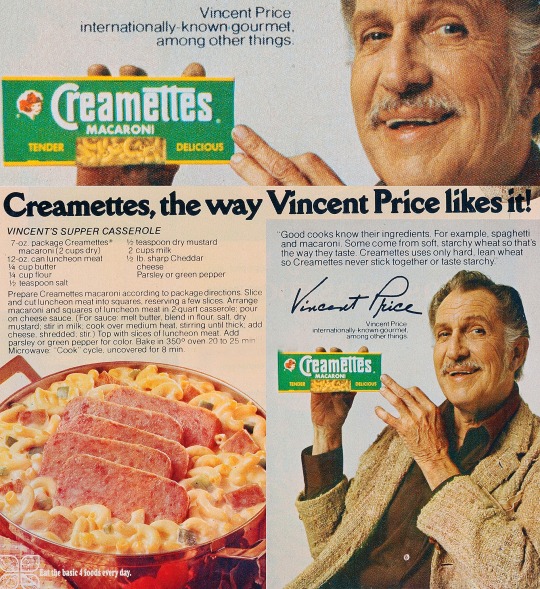
In 1977, Vincent Price teamed up with Creamettes to share a delicious recipe... I have to try this.
#vincent price#creamettes#noodles#spaghetti#elbow macaroni#macaroni#recipe#food recipes#vintage ad#advertising#1970s ad#food#bicon#bisexual#god#god i love him#he could GET it#i desire him carnally#that is all#i want just a crumb...only a crumb#please sir#horror#old horror movies#vintage#movie#actor#handsome#photo#photo edit by me#magazine
115 notes
·
View notes
Text
Forgotten Cookies
Angel in the Kitchen Cookbook, Angel Society of Fallbrook.

45 notes
·
View notes
Text
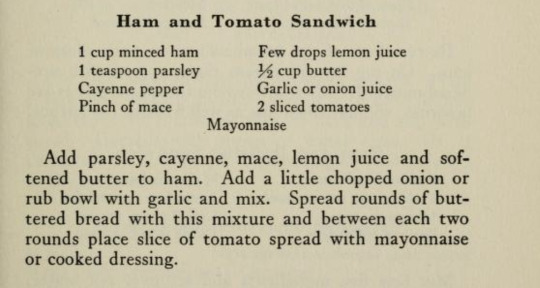


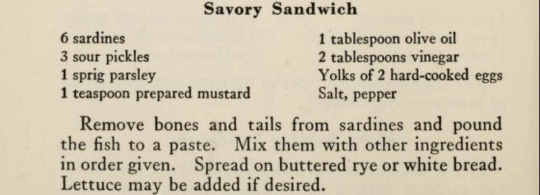








Some interesting sandwiches from 1001 sandwiches
I also thought this was funny:
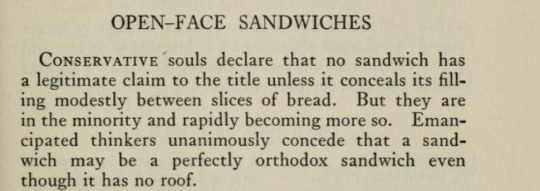
141 notes
·
View notes
Text
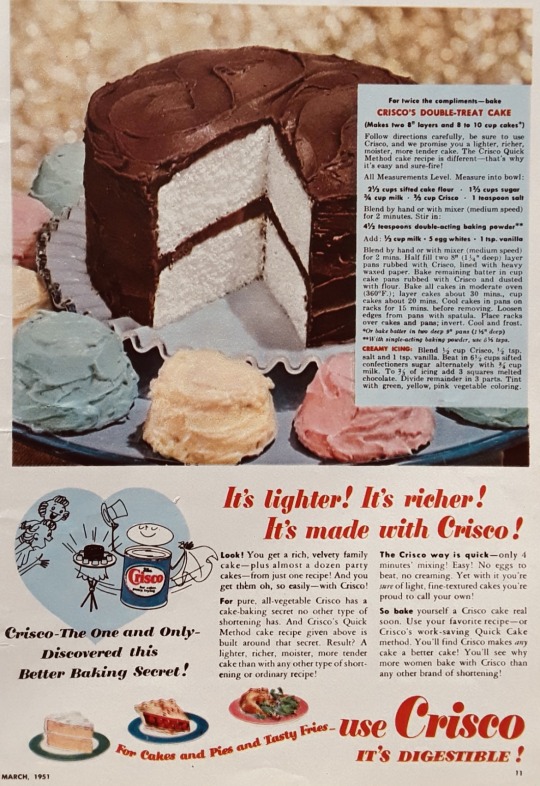
1951 Crisco advertising
#1951#crisco#bake#cake#vintage recipe#cerealkiller#vintage food#food#vintage advertising#vintage magazine#kitchen#magazine#1950s#50s#50s ads
118 notes
·
View notes
Text

Got another vintage recipe challenge for y’all: “mahogany sauce”, a blend of coffee and grape drink plus some butter and rum
60 notes
·
View notes
Video
tumblr
Christmas time means cookie time!
#video#tiktok#tiktoks#funny#lmao#wtf#food#recipe#recipes#vintage#cookie#cookies#boiled cookies#bdylanhollis
8K notes
·
View notes
Text
Meat and fruit can certainly be combined in interesting and delicious ways. Think of the humble date in bacon. The fancy duck a l'orange. The controversial pineapple on pizza. But there are limits. There are limits and Germany in the 1980s found every single one of them.
117 notes
·
View notes
Text
113 notes
·
View notes
Text

#cheese#gourmet cheese#foodies#masterclass#wine and cheese#fromage#cheese boards#wine#vintage#caviar#grilled cheese#vintage wine#etherealuploads#etherealarte#explore#travel#la dolce vita#dolce far niente#foodgasm#food#foodie#foodporn#foodpics#food photography#recipe#bread#seafood#french food#italian food#pinterest
30 notes
·
View notes
Text

Van Camp Sea Food Co, 1939
#Chicken of the Sea#ad#1939#tuna fish#vintage#advertisement#1930s#White Star brand#illustration#magician#presto!#advertising#grated#recipes#mealtime#food
121 notes
·
View notes